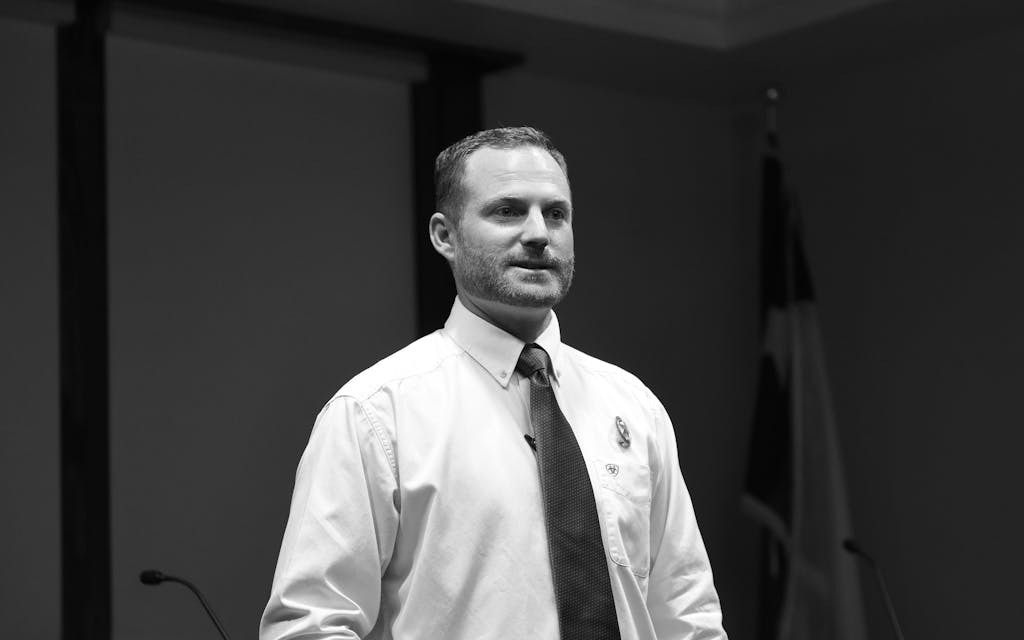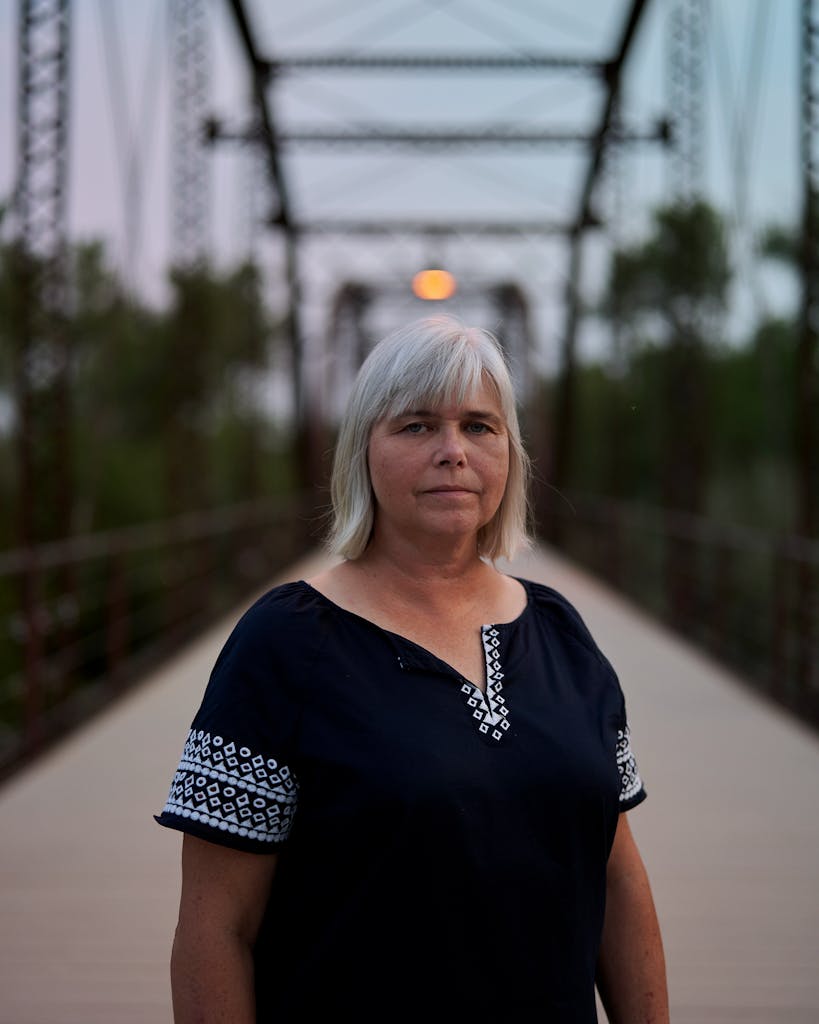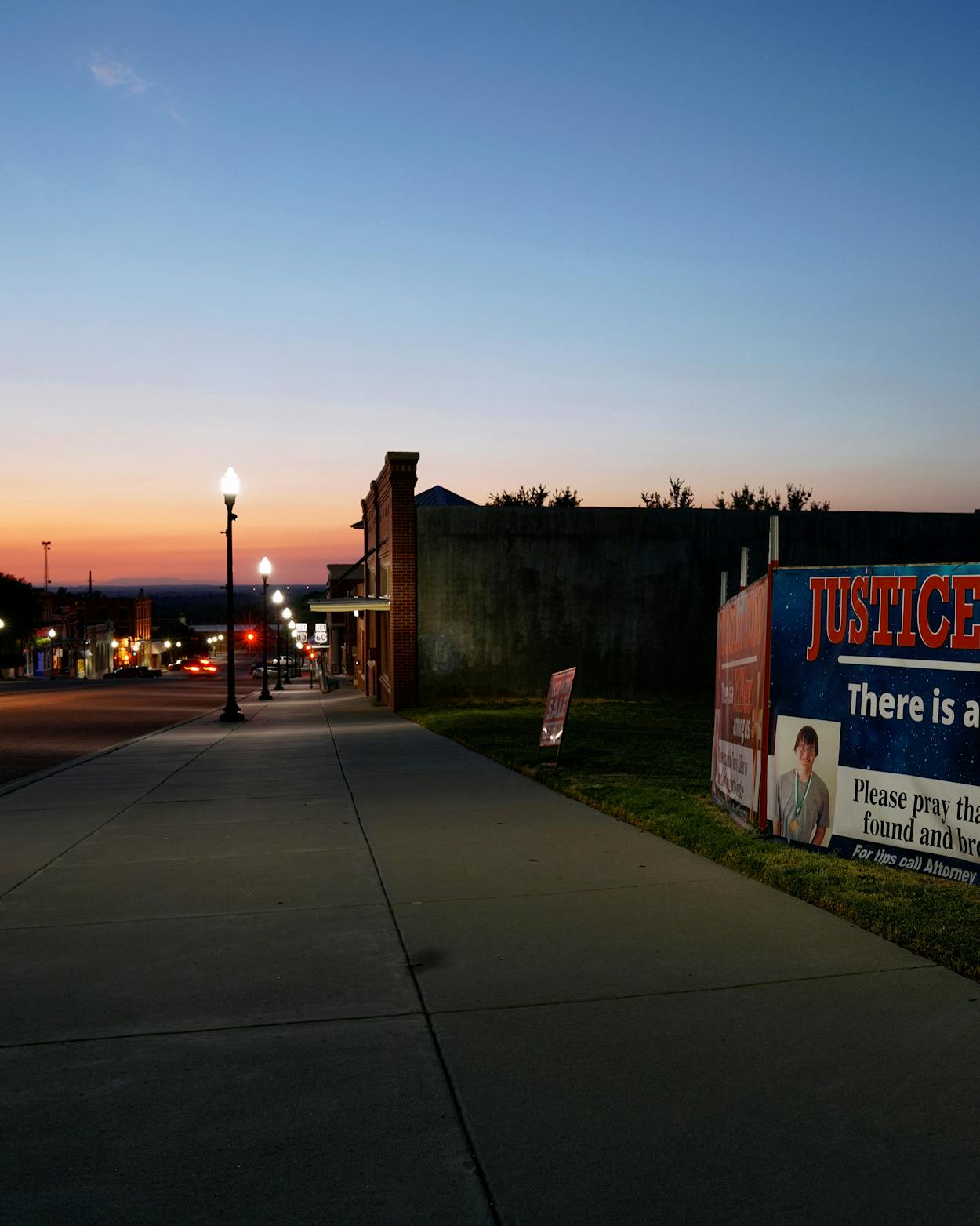Subscribe
In August 2019, Hemphill County Sheriff Nathan Lewis received a visit from a couple of officers from the Texas Commission on Law Enforcement, the regulatory agency for all peace officers in the state. The TCOLE is responsible for verifying that officers fulfill their continuing education requirements, and the officers informed Lewis that the agency would be investigating allegations that he had committed “document fabrication” by submitting reports that falsely detailed training hours completed by three deputies and himself.
Lewis told me he later met with Hemphill County officials, who asked for his resignation. “The county attorney said, ‘Hey, Nathan, we have way too much heat on us [over the Tom Brown case],’ ” Lewis recalled. “ ‘The media is making us look horrible. We need to heal as a community and basically get away from all this.’ ”
Lewis said he and the other deputies had actually completed their training hours but that he had simply submitted the reports incorrectly. Nevertheless, he decided to quit anyway. “I was just fed up with going through all this stuff and all the lies and all the rumors and social media, and so I just said, ‘I’m done with this. I didn’t sign up for this. This is ridiculous.’ ”
In a statement released to the public, Lewis wrote, “I am very happy and humble for the great things we’ve accomplished in the three years as sheriff. My word to you is this: spend time with your family and enjoy everything God is giving you.”

But it’s doubtful Lewis found much time to relax. The Canadian rumor mill hadn’t stopped churning. And one of the biggest rumors now making its way through town was that the private investigator Phillip Klein had new evidence linking Lewis to Tom’s murder.
Klein told me he had been talking to a couple of the town’s residents—he wouldn’t identify them or tell me their ages—who were feeding him an entirely new story about what had happened on Thanksgiving eve 2016. Allegedly, after saying goodbye to Christian Webb, Tom had filled his Durango with gas. Because he had a few minutes left before his curfew, he drove to the parking lot of the high school football stadium, where Canadian kids occasionally gathered. Klein said someone who was there (he wouldn’t identify that person either) had sneaked up behind Tom, who was sitting inside his Durango with the window down. This individual pulled out a .25-caliber pistol, and, in Klein’s words, “started messing with him.”
Klein said the person with the pistol had no desire to shoot Tom. He was just wanting to give Tom a little scare. But he accidentally pulled the trigger. The bullet entered through the top of Tom’s neck and lodged in his brain. The bullet’s shell casing landed on the truck’s floorboard. According to Klein, Tom’s killer pushed Tom into the back seat, drove out to Lake Marvin Road, dumped Tom under the thicket of cottonwood trees, cleaned the blood from the Durango’s interior, and drove back into town to find a place to stash the car. He finally found a spot on the outskirts, by the water treatment plant.
And that wasn’t all, Klein said. “There’s a possibility that some law enforcement may be involved in either the actual event or the cover-up,” he told me. “If it was not a law enforcement officer that actually pulled the trigger, it was somebody that’s connected close to law enforcement who was willing to help clean up a mess.”
I asked Klein why a law enforcement officer would want Tom dead. His response was vague. “Acrimonious relationships,” he replied. “We believe that there was a period of a bad relationship between families up there.”
During another conversation, Klein acknowledged that his sources had told him the law enforcement officer was Lewis. Klein added further details, claiming there were in fact two teenage boys who had been messing with Tom in the football stadium parking lot and that one of them had accidentally pulled the trigger. (Klein still wouldn’t identify either teenager.) Panicking, one of them made a phone call, most likely to his father or a friend of his father’s, Klein said. Then that adult called Lewis, a close friend.
“And the sheriff told them to do what?” I asked.
“Cover it up,” Klein said. “Cover up the crime.”
“Did Lewis recommend dumping the body on Lake Marvin Road?”
“We don’t know that. Speculation is, and some of the rumor is that, yes, he was involved with saying, ‘Take it out there.’ ”
When I asked Klein what evidence he had to prove Lewis’s involvement, he said, confidently but hazily, “We do have some evidence that leads us to that theory. We just didn’t pop that theory in our minds. That never just came out of the blue. We have some evidence from what some witnesses are telling us.”

It was, in typical Klein fashion, an eye-popping tale—and a curious one. If Lewis had assisted with a cover-up, that would explain some of the so-far unexplainable details. Lewis could have told the two boys to plant the backpack a third of the way down Lake Marvin Road. He also could have confiscated Tom’s phone, which he could have later planted by the road just prior to Klein’s search.
But why would the young sheriff, who in November 2016 had been in office for only three months, have gotten caught up in a tragic accident? Klein, of course, had floated certain motives in the past. Was Lewis really that upset with Tom’s mother, Penny Meek, for the dispute they had had back in 2015 over the way he had allegedly treated Tom outside Canadian’s movie theater? Did someone who had supposedly contacted him after the shooting know something scandalous about Lewis’s life that he threatened to reveal if the sheriff didn’t assist with the cover-up?
When I called Lewis to talk about Klein’s accusations, he let out a laugh. “That’s like a movie,” he said. “I don’t understand where he comes up with stuff like this. It’s really funny. I mean, he’s supposed to be a big investigator, and that’s his theory? Holy moly.”
Lewis said he’d never gotten a call from anybody saying there had been a shooting at the high school football stadium parking lot and that he never told anyone to hide Tom’s body on Lake Marvin Road. “That’s crazy. I mean, what in the world? It’s crazy he can just say this stuff and people get to hear it.”
So, I asked Lewis, what did he believe happened on Thanksgiving eve? He gave me a one-word answer: Penny. “She’s involved,” he said. “She knows something. She knows so much about what’s going on.”
Like the investigators Rachel Kading and Chris Smyth, Lewis didn’t rule out the possibility that Penny had found Tom’s body after he’d killed himself. He suspected she then hid the body out of shame, perhaps even persuading her husband or her older son to help her.
There was no question that Penny’s behavior could sometimes be inexplicable. In 2017, for a Halloween costume party at the elementary school where she taught technology classes, Penny had gone as Sheriff Lewis, with a cowboy hat and a badge. Penny said she chose the outfit because some of her coworkers, including a couple of teachers who also disliked Lewis, “thought it would be amusing.” But others questioned it. How was it amusing to dress up as the person you’d accused of being involved in your son’s disappearance or murder? “She’s crazy as hell,” Lewis told me. “Man, there is something scary about her.”
Penny knew that many Canadian residents treated her and her family as pariahs. “They just think that Thomas committed suicide and that we know it and we just need to get over it and move on. And in the meantime, we’ve ruined the sheriff and his family’s life.” Penny said they’ve even been blamed for a faltering economy; it just so happened that an oil bust had begun ravaging the region the same year Tom disappeared. “The economy here is bad because we gave Canadian a black eye. It’s our fault people don’t want to come here. And I’m like, ‘I’m pretty sure I didn’t make the oil field go away, but if you want to think I did that, then that’s fine.’ ”
Penny’s friends, however, defended her as a loving mother overwhelmed with grief over the loss of her son. “She would have done anything for Tom,” said Mary Alice Hughes, who first met Penny when she was a freshman and Penny was in eighth grade. “And she did everything that she could think of doing to find him. Everything.”
During one of our conversations, Penny told me she had continued texting Tom for more than a year after he’d disappeared, hoping that he was still alive and that he would someday turn on his phone, see all of her messages, and respond. I asked her to read some of them. She pulled out her phone. “On February fourteenth, I said, ‘Happy Valentine’s Day. Love you.’ On May seventh, ‘You were honored today at church for Senior Sunday.’ ” Penny tried to read one more. But she got choked up and couldn’t continue.
Listening to her read the texts, I teared up myself. It wasn’t until later that night that I considered the allegations that Lewis, Kading, and Smyth had leveled against her. If Penny had indeed found and moved Tom’s body, that would also mean she knew her son was dead when she sent all those texts to his phone.

This past January, five months after the state attorney general’s office suspended its investigation into Tom’s death because of a lack of evidence, I got a call from a source in Canadian who told me that Rachel Kading was back in town. Perhaps because the pandemic was surging at the time, Kading stayed for only a few days. Lewis said he never heard from her. Penny said Kading hadn’t paid her a visit either.
Kading was, however, spotted in Salem Abraham’s downtown office interviewing one of his employees, who happened to be the woman who’d found Tom’s cellphone. Someone said she thought she saw Kading talking to the new sheriff, Lewis’s former chief deputy Brent Clapp. Someone else claimed they saw her driving down Main Street, past the “Justice for Tom” signs.
A few months passed. Then, in August, the case took another turn that caught me by surprise. My source called again and said the latest rumor going around town was that a grand jury would be convened to hear testimony about Tom Brown’s death and that Kading was going to present new evidence. I called a media spokesman for the attorney general’s office. Yes, he said: a grand jury would be convened in Hemphill County either later this year or in early 2021. Various citizens would be subpoenaed to testify under penalty of perjury.
Suddenly, in households across Canadian, everyone was asking the same question: what new evidence had Rachel Kading unearthed?
Suddenly, all across Canadian, everyone was asking the same question: What new evidence had Rachel Kading unearthed? Neither Lewis nor Klein would comment on the upcoming grand jury hearing. Klein did tell me he was still seeking evidence to support the most recent of the many theories he has floated about the case. He said he was trying to get a confession, either from one of the boys who had allegedly killed Tom in the high school parking lot or from one of the men the boys had called to ask for help.
Although she admitted she had no evidence, Penny said what made the most sense to her was that Lewis himself shot Tom in the school parking lot. “Pulled up behind him,” Penny said, “and started messing with him and perhaps accidentally shot him. And then it was like, ‘Oh, shit, I got to cover this up. I’m a new sheriff; this will ruin my career, so I got to take care of this.’ ”
In another conversation, however, Penny backed off her theory that Lewis was responsible. She said she wasn’t sure what, if anything, took place in the parking lot. “All I want is for the truth to come out,” she said. “All I want is for someone to tell me what happened to my son.”
Will we ever know what happened to Tom Brown?
When I started working on this story almost a year ago, I assumed that the truth about Tom’s case would eventually come out. I assumed the “Justice for Tom” signs would be removed and peace would return to the small town.
But I now wonder whether some questions will remain unanswered. Will we ever know who parked Tom’s Durango by the water treatment plant? Who placed his cellphone near Lake Marvin Road? And who, if anyone, other than Tom positioned his body under the cottonwood trees? There are still so many secrets, and there’s no guarantee a grand jury will dislodge new information.

After it was announced that a grand jury would be convened, I called Tom’s friend Christian Webb. Christian graduated in May from Oklahoma State and landed a job as a forensic scientist at the Department of Public Safety in Waco. She had entered that profession largely because of Tom. “I want to help people in the way that he wasn’t helped,” she said. “I think a big reason as to why we know as little as we do about Tom is because there wasn’t [enough solid] forensics work done from the start.”
I asked Christian if she had reached any new conclusions about the case. She replied that she too now believes “it might be a mystery that will never be solved.” In the first months after Tom’s disappearance, she said, “I was pretty sure that Nathan Lewis had something to do with it. But now I am not sure who was involved. I really don’t know, and I don’t have any ideas anymore of who it could be.”
Christian still doesn’t come home very often. When she does, she said, she feels like she gets “PTSD or something,” especially when she drives around town, following the route she and her friends used to call “Tom’s loop.”
“I wonder what I could have done for Tom if I had stayed around a little bit longer [that night],” she said. “If someone had something to do with his disappearance, I could have tried to protect him. Maybe that person wouldn’t have messed with Tom in the first place if a second person was there. It’s very hard for me to think about.”
Christian also told me something I wasn’t expecting. She said that despite all the time that’s passed since Tom vanished, “I’m definitely more paranoid wherever I go. I definitely watch my back more and pay attention to what’s going on around me, just to make sure that what happened to Tom doesn’t happen to me and doesn’t happen to people around me.”
“Because you think there’s still a killer in town?” I asked.
Christian didn’t hesitate. “Yes, sir,” she said.
Read more from the Tom Brown’s Body Series:
Chapter 1: A Pretty Little Place
Chapter 3: “Evil Has Come to Canadian, Texas”
This article originally appeared in the December 2020 issue of Texas Monthly with the headline “Tom Brown’s Body.” Subscribe today.









